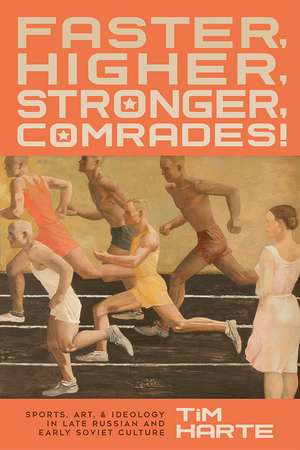Faster, Higher, Stronger, Comrades!: Sports, Art, and Ideology in Late Russian and Early Soviet Culture
Autor Tim Harteen Limba Engleză Hardback – 6 iul 2020
The revival of the Olympic games in 1896 and the subsequent rise of modern athletics prompted a new, energetic movement away from more sedentary habits. In Russia, this ethos soon became a key facet of the Bolsheviks' shared vision for the future. In the aftermath of the revolution, glorification of exercise persevered, pointing the way toward a stronger, healthier populace and a vibrant Socialist society.
With interdisciplinary analysis of literature, painting, and film, Faster, Higher, Stronger, Comrades! traces how physical fitness had an even broader impact on culture and ideology in the Soviet Union than previously realized. From prerevolutionary writers and painters glorifying popular circus wrestlers to Soviet photographers capturing unprecedented athleticism as a means of satisfying their aesthetic ideals, the nation's artists embraced sports in profound, inventive ways. Though athletics were used for doctrinaire purposes, Tim Harte demonstrates that at their core, they remained playful, joyous physical activities capable of stirring imaginations and transforming everyday realities.
With interdisciplinary analysis of literature, painting, and film, Faster, Higher, Stronger, Comrades! traces how physical fitness had an even broader impact on culture and ideology in the Soviet Union than previously realized. From prerevolutionary writers and painters glorifying popular circus wrestlers to Soviet photographers capturing unprecedented athleticism as a means of satisfying their aesthetic ideals, the nation's artists embraced sports in profound, inventive ways. Though athletics were used for doctrinaire purposes, Tim Harte demonstrates that at their core, they remained playful, joyous physical activities capable of stirring imaginations and transforming everyday realities.
Preț: 467.93 lei
Preț vechi: 607.70 lei
-23% Nou
Puncte Express: 702
Preț estimativ în valută:
89.58€ • 93.11$ • 74.27£
89.58€ • 93.11$ • 74.27£
Carte tipărită la comandă
Livrare economică 06-20 februarie 25
Preluare comenzi: 021 569.72.76
Specificații
ISBN-13: 9780299327705
ISBN-10: 0299327701
Pagini: 328
Ilustrații: 15 color, 30 b-w illus.
Dimensiuni: 152 x 229 x 25 mm
Greutate: 0.59 kg
Ediția:1
Editura: University of Wisconsin Press
Colecția University of Wisconsin Press
ISBN-10: 0299327701
Pagini: 328
Ilustrații: 15 color, 30 b-w illus.
Dimensiuni: 152 x 229 x 25 mm
Greutate: 0.59 kg
Ediția:1
Editura: University of Wisconsin Press
Colecția University of Wisconsin Press
Recenzii
“This is a lively and engaging study that explores the impact ofsports on the cultural world of both pre- and postrevolutionary Russia. The numerous analyses of works from the worlds of literature, film, cinema, and photographyare both fresh and insightful.”—Barry Scherr, Dartmouth College
“An exciting, thoughtful volume, with a wide-ranging purview, impressively thorough research, original perspective, eloquently bold collocation of pertinent texts, and many fascinating aperçus. This eminently readable study is a must for Slavists and lovers of sport.”Helena Goscilo, The Ohio State University
“A beautifully researched and significant contribution to our understanding of part of the DNA of early Soviet culture.”—Australian Slavonic and East European Studies
“Provides tremendous insight and analysis. . . . A great read. . . . Harte fills in the gaps of collective historical memory with this examination of athletics and art in a nation shrouded in secrecy for much of the past century. While artistic renditions of Babe Ruth, Jesse Owens, and Rocky Marciano celebrated American culture, we now can learn more about their Russian/Soviet counterparts thanks to Harte’s multidisciplinary efforts.”—Journal of Sport History
Notă biografică
Timothy Harte is a professor of Russian at Bryn Mawr College. He is the author of Fast Forward: The Aesthetics and Ideology of Speed in Russian Avant-Garde Culture, 1910–1930 and the coeditor of Women in Soviet Film: The Thaw and Post-Thaw Periods.
